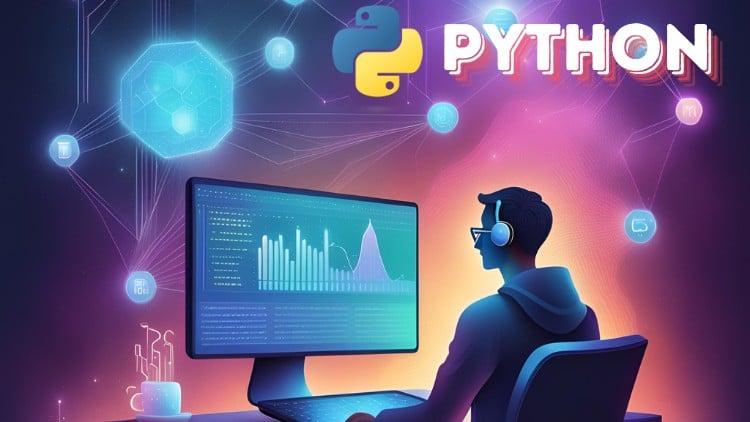Last Updated on April 5, 2025 by TANWEER
Course : Python For Data Science – Real Time Experience
“`htmlPython for Data Science: Your Comprehensive Guide
Welcome to the realm of Python for Data Science, where programming meets analytics! Whether you’re just starting your journey in coding or looking to enhance your skills, this article will guide you through the essentials of Python. It’s an incredible programming language that has become a favorite in the data science community.
Why Choose Python for Data Science?
Python is not just popular because of its simplicity but also due to its powerful libraries and frameworks tailored for data analysis. Here are a few reasons why Python is the go-to choice for data science:
- Readability: Python’s syntax is similar to English, making it accessible for beginners.
- Rich Libraries: Libraries like Pandas, NumPy, and Matplotlib make data manipulation and visualization straightforward.
- Community Support: A large community means plenty of resources, documentation, and frameworks.
Getting Started with Python
Installation and Setting Up Jupyter Notebook
The first step in our Python for Data Science journey is setting up the Jupyter Notebook, an interactive coding environment. To get started:
- Install Anaconda, which comes with Jupyter and other necessary packages.
- Launch Jupyter Notebook via Anaconda Navigator or command line.
- Create a new Python notebook to start coding!
With Jupyter Notebook, you can write code in segments (cells), which allows for immediate feedback — perfect for experimenting and learning.
Core Concepts in Python for Data Science
As we explore Python for Data Science, we’ll cover several foundational concepts that are key for any aspiring data scientist. Let’s dive into these!
1. Variables
In Python, a variable acts as a container for storing data. For example:
a = 10
b = 20.5
c = "Data Science"
You can refer to these variables later in your code to perform operations and analysis.
2. Data Types
Python has several built-in data types including:
- Integers: Whole numbers like 1, 2, 3.
- Floats: Decimal numbers such as 1.5, 2.7.
- Strings: Text data like “Hello, World!”
- Lists: Ordered collections of items:
my_list = [1, 2, "abc"]. - Dictionaries: Key-value pairs:
my_dict = {"name": "John", "age": 30}.
3. Control Flow
Python allows you to control the flow of your code using loops and conditionals. For instance, you can use if statements to execute code based on conditions:
if a > b:
print("a is greater than b")
else:
print("b is greater than a")
4. Functions
Functions are blocks of reusable code. You define a function using the def keyword:
def greet(name):
return "Hello, " + name
Now you can call this function multiple times:
print(greet("Alice"))
print(greet("Bob"))
Advanced Concepts in Data Science
5. Libraries to Explore
For those diving deeper into Python for Data Science, here are some libraries that are indispensable:
- Pandas: For data manipulation and analysis.
- NumPy: For scientific computing and handling arrays.
- Matplotlib: For plotting and visualizing data.
- Scikit-learn: For machine learning algorithms.
- Seaborn: For statistical data visualization.
6. Data Manipulation using Pandas
Pandas is a powerful tool for data analysis. For example, you can quickly read and manipulate data using:
import pandas as pd
data = pd.read_csv('data.csv')
data.head() # Displays the first five rows of the dataset
This snippet loads a dataset and displays its first few records, allowing you to get a quick glimpse of the data you are working with.
7. Visualization with Matplotlib and Seaborn
Visualizing data is crucial for understanding trends. Here’s how you can create a simple line plot:
import matplotlib.pyplot as plt
plt.plot(data['date'], data['value'])
plt.title('Data Over Time')
plt.xlabel('Date')
plt.ylabel('Value')
plt.show()
This small piece of code plots your data in a visually appealing way!
Free Resources to Learn Python for Data Science
If you’re looking for ways to get started without breaking the bank, consider these resources. You can find many free Udemy coupons for Python for Data Science. Here are a few worth checking out:
- Udemy Python Courses – Search for free coupons often offered.
- Coursera – Offers some free courses on Python for Data Science.
- edX – Has many free courses from top universities.
- Google’s Python Class: A free class for people with a little bit of programming experience.
- Codecademy: Offers interactive learning experiences for Python.
FAQs About Python for Data Science
1. What is Python used for in data science?
Python is used for data analysis, visualization, machine learning, and more. It’s versatile and has libraries that simplify these processes.
2. Do I need to know programming to learn Python?
No, Python is beginner-friendly. You don’t need prior programming experience to start learning!
3. How long does it take to learn Python for data science?
The timeline varies depending on your pace, but you can get a good grasp in a few weeks with consistent practice.
4. Are there free Udemy coupons for learning Python for Data Science?
Yes, there are many free Udemy coupons for Python for Data Science available online. Be sure to grab them!
5. What are the best Python libraries for data science?
Some of the essential libraries include Pandas, NumPy, Matplotlib, and Scikit-learn among others.
Conclusion
Embarking on the journey of Python for Data Science opens countless avenues for analysis, problem-solving, and innovation. From understanding basic concepts to mastering libraries, Python proves to be a potent tool in the hands of data scientists. Don’t forget to utilize the free Udemy coupons for Python for Data Science to enhance your learning experience. Embrace this journey, and soon you’ll find yourself fluent in the language of data!
“`














